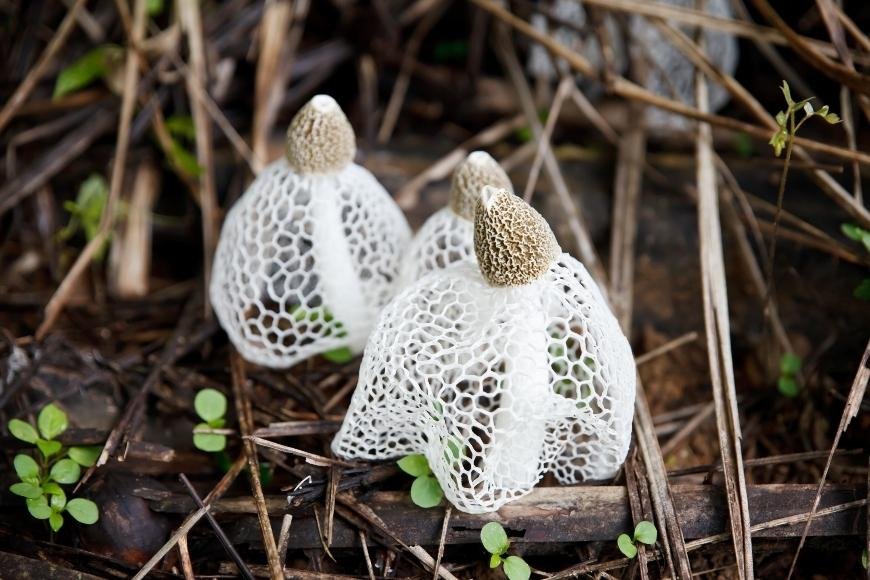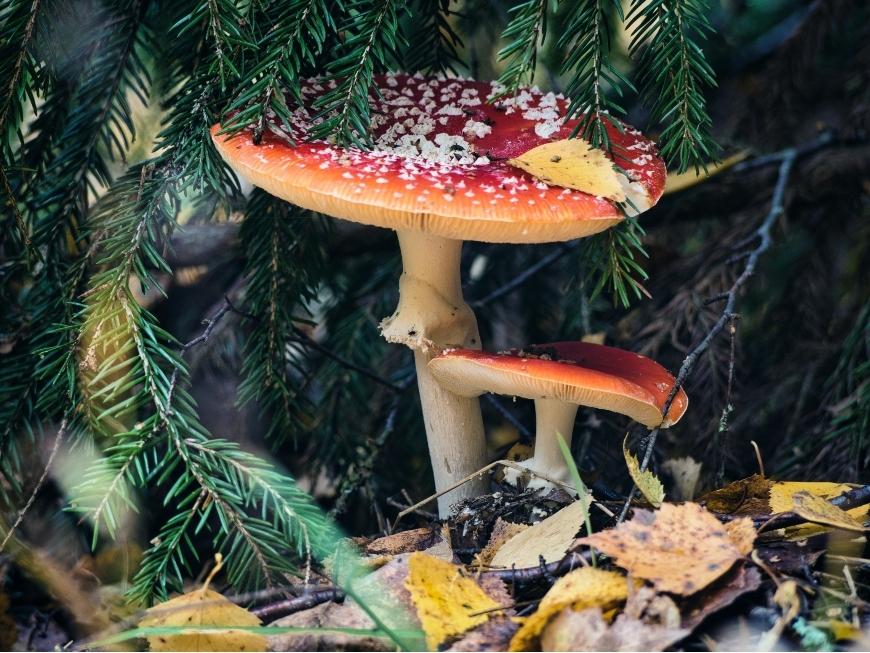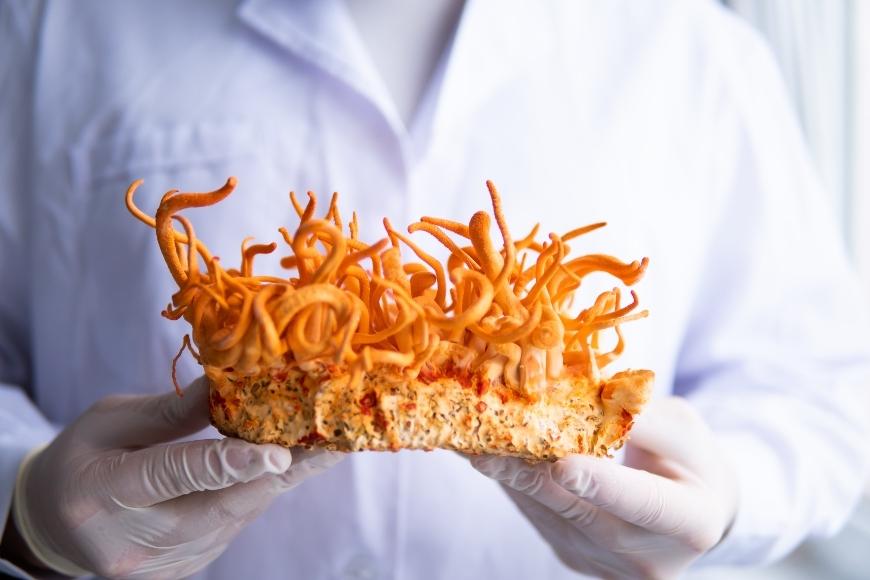The Weirdest Mushrooms on the Planet
Discover the weirdest mushrooms on the planet, their unique features, ecological roles, and potential uses in our captivating fungi showcase!

The Weirdest Mushrooms on the Planet are not only fascinating to observe, but they also offer a glimpse into the diverse world of fungi. These strange mushrooms have captivated the minds of many and still astound those who come across them.
In this blog post, we'll uncover some of the most peculiar and extraordinary mushrooms found across our planet. From species that emit an odor reminiscent of rotting flesh to those that grow exclusively on coniferous trees, these weird mushrooms showcase nature's incredible adaptability and creativity.
As we explore these captivating specimens further, you'll learn about their ecological significance, cultural references, potential uses in various industries such as medicine or cuisine, interesting facts surrounding each mushroom type – all while appreciating their unique beauty and strangeness. So join us in discovering The Weirdest Mushrooms on the Planet!
Table of Contents:
- The Weirdest Mushrooms on the Planet
- Unusual Features of Bizarre Mushrooms
- Ecological Significance and Cultural References
- Potential Uses and Benefits of Unusual Mushrooms
- Interesting Facts and Anecdotes About Each Mushroom
- Uncovering the Beauty, Strangeness, and Ecological Significance of Mushrooms
- A Showcase of Fascinating Mushrooms
- FAQs in Relation to the Weirdest Mushrooms on the Planet
- Conclusion
The Weirdest Mushrooms on the Planet
Welcome to the fascinating world of mushrooms. From the thousands of known species and those still to be discovered, mushrooms come in a variety of sizes, shapes, and colors - some more peculiar than others. Let's explore some of the weirdest mushrooms found across our planet.

Stemonitis Fusca
First up, we have Stemonitis fusca, also known as chocolate tube slime mold. Despite its name, it's not actually a fungus but rather belongs to a group called myxomycetes or slime molds. Myxomycetes, or slime molds, possess the remarkable ability to transition between unicellular and multicellular forms.
Panellus Stipticus
If you're into glowing things (who isn't?), then you'll love Panellus stipticus. This bioluminescent mushroom emits an eerie green glow at night due to luciferin-luciferase reactions within its cells. Only around 80 species of fungi are known to have the ability to glow.
Aseroe Rubra
- Aseroe rubra: Also called starfish fungus or sea anemone fungus for its striking resemblance to marine life.
Aseroe rubra is a unique mushroom that looks like a bright red starfish or sea anemone. It's found in Australia and New Zealand and is known for its pungent odor.
Clathrus Archeri
- Clathrus archeri: Commonly referred to as devil's fingers or octopus stinkhorn due to its tentacle-like projections emitting foul odors.
Clathrus archeri is a bizarre mushroom that looks like a hand reaching out of the ground. Its tentacle-like projections emit a foul odor that attracts flies and other insects to spread its spores.
Cyathus Striatus
- Cyathus striatus: Known as splash cups or bird's nest fungi, these tiny mushrooms resemble miniature bird nests filled with "eggs" (spore-containing structures).
Cyathus striatus is a tiny mushroom that looks like a miniature bird's nest filled with "eggs." These "eggs" are actually spore-containing structures that are dispersed by raindrops hitting the cup-shaped mushroom.
These are just a few examples of the incredible diversity found within the world of mushrooms. As we continue our exploration, you'll learn about even more bizarre species and their unique features. So buckle up for an exciting adventure into the realm of weird and wonderful fungi.
Unusual Features of Bizarre Mushrooms
Our planet is home to an astonishing variety of mushrooms, each with its own unique features and peculiarities. Some of the most extraordinary examples include:
- Devil's Fingers (Clathrus archeri): This bizarre mushroom resembles a creature from another world, with its long red tentacles emerging from a dark egg-like structure.
- Ghost Plant (Monotropa uniflora): Also known as Indian Pipe or Corpse Plant, this ghostly white fungus lacks chlorophyll and relies on mycorrhizal fungi for nutrients.
- Collared Earthstar (Geastrum triplex): A fascinating species that forms a star-shaped structure around its central spore sac, which can release spores when disturbed by raindrops or animals.
Beyond their striking appearances, these unusual mushrooms also exhibit some remarkable characteristics. For instance, the bioluminescent Panellus stipticus, commonly known as the "bitter oyster," emits a soft green glow in the dark due to a chemical reaction within its cells. Another example is the parasitic fungus called Cordyceps, which infects insects and alters their behavior before sprouting fruiting bodies out of their hosts' bodies.
In addition to these captivating oddities are mushrooms that play essential roles in ecosystems worldwide. For example, the lichen is a symbiotic partnership between fungi and algae or cyanobacteria that helps break down rocks and create soil. Similarly, mycorrhizal fungi form mutually beneficial relationships with plant roots, exchanging nutrients for sugars produced by photosynthesis.
Discovering the Fascinating World of Fungi
At first look, some of these strange fungi may seem unearthly or even unnerving; however, they are a key part of the abundant biological variety on our planet. By learning more about their unique features and ecological roles, we can better appreciate the fascinating world of fungi all around us.
Ecological Significance and Cultural References
Mushrooms are remarkable organisms that have an essential influence on our environment. They act as decomposers, breaking down organic matter and recycling nutrients back into the soil. Some weird mushrooms even form symbiotic relationships with plants, helping both organisms thrive.
Apart from their ecological significance, mushrooms have also been embedded in culture for centuries. Take the Amanita muscaria, for example. The Amanita muscaria, an iconic mushroom with its red cap and white spots, has been widely celebrated in art, literature and even video games such as Super Mario Bros.
Psychedelic Mushrooms
- Amanita muscaria: Known for its hallucinogenic properties, this mushroom has played a role in shamanistic rituals among indigenous Siberian tribes. It may also be connected to ancient Norse mythology surrounding berserkers who consumed it before battle.
- Panaeolus cinctulus: Also called banded mottlegill or weed Panaeolus due to its association with manure piles. This small brownish-grey mushroom contains psilocybin - a potent psychedelic compound responsible for inducing mind-altering experiences.
Unusual Mushrooms
- Clathrus ruber: Commonly known as the red cage fungus, this bizarre mushroom resembles a bright red lattice structure. It releases a foul-smelling odor to attract flies for spore dispersal. Its unique appearance has inspired various artists and designers in their work.
These mushrooms have been used throughout history for medicinal purposes, spiritual exploration, and even culinary delights. By exploring the stories behind these strange fungi, we can gain a deeper appreciation for their place in our world - both ecologically and culturally.
Potential Uses and Benefits of Unusual Mushrooms
As you dive deeper into the world of extraordinary mushrooms, it's important to recognize their potential uses and benefits. These peculiar fungi not only captivate us with their appearance but also offer a range of applications in various fields.
Medicinal Properties
One significant aspect that sets some unusual mushrooms apart from others is their medicinal properties. For instance, Lion's Mane (Hericium erinaceus) is known for its brain-boosting abilities, while Chaga (Inonotus obliquus) has been used as an immune system enhancer. Investigations into psychedelics like Psilocybe cubensis keep uncovering potential benefits for psychological ailments, including anxiety and depression.
Ecological Roles
These fascinating organisms play crucial ecological roles. Fungi like the Devil's Tooth (Hydnellum peckii), which exudes a blood-like substance when young, help break down organic matter in forests by decomposing dead plant material. This process contributes significantly to nutrient cycling within ecosystems.
Artistic Inspiration
Beyond medicine and ecology, unique mushroom species have inspired artists and designers worldwide due to their bizarre appearances or bioluminescent properties. For example, Panellus stipticus, commonly known as bitter oyster or luminescent panellist fungus, emits greenish light at night, making them perfect candidates for artistic installations using natural materials.
Unusual Mushroom Species
- Fairy Inkcap (Coprinellus disseminatus): This delicate, umbrella-like mushroom often grows in clusters on decaying wood and has been used as a natural dye for textiles.
- Veiled Lady (Phallus indusiatus): The intricate lace-like skirt that surrounds this stinkhorn fungus is not only visually stunning but also serves as an attractant for insects to help disperse its spores.
- Violet Coral (Clavaria zollingeri): This vibrant purple coral-shaped fungus adds a pop of color to the forest floor and can be utilized in floral arrangements or other decorative displays.
Exploring the potential uses and benefits of unusual mushrooms highlights their importance beyond mere oddities. These extraordinary fungi offer valuable insights into medicine, ecology, art, and design while continuing to enchant us with their peculiar features.
Interesting Facts and Anecdotes About Each Mushroom
Dive into the fascinating world of weird mushrooms by learning about some intriguing facts and anecdotes associated with them.
The Bleeding Tooth Fungus
Also known as Hydnellum peckii, this mushroom is famous for its striking appearance. It exudes a blood-like substance from its pores, giving it an eerie look. While not toxic, it's inedible due to its bitter taste. This fungus has a special bond with conifers, aiding them in taking up nourishment more effectively.
The Bioluminescent Panellus stipticus
This enchanting mushroom emits a greenish glow at night thanks to bioluminescence caused by luciferin-luciferase reactions within the fungus cells. The glow attracts insects that help disperse spores throughout the forest floor. For further information about bioluminescent fungi, please click here.
The Devil's Cigar
Known scientifically as Chorioactis geaster, this rare mushroom resembles a cigar before opening up like a starfish when releasing spores. Found only in Texas and Japan, researchers are still puzzled over how these two distant populations came to be.
Amanita muscaria (Fly Agaric)
With its iconic red cap covered in white spots, Amanita muscaria has been featured prominently in fairy tales and pop culture references such as Super Mario Bros games or Alice In Wonderland movie adaptations.
Largest Living Organism
The Armillaria ostoyae, also known as the honey mushroom, holds the record for being one of the largest living organisms on Earth. Frequently found in Oregon's Malheur National Forest, a massive organism spanning 3.7 sq mi has been estimated to be over two millennia old.
The Magic Mushroom Connection
For centuries, psilocybin mushrooms have been employed in various cultures for spiritual and healing purposes. Recent studies have suggested that psilocybin-assisted therapy may be effective in treating certain mental health issues such as depression and anxiety.
These captivating facts showcase just a glimpse into the vast world of extraordinary mushrooms that await discovery.

Uncovering the Beauty, Strangeness, and Ecological Significance of Mushrooms
Mushrooms are frequently disregarded, yet these remarkable organisms flaunt a singular beauty that can be admired by anyone eager to take a closer examination. The strangest mushrooms on our planet showcase an incredible range of shapes, colors, and textures - from the delicate slime molds to the eerie devil's fingers mushroom.
The ecological importance of mushrooms cannot be overstated. As decomposers, they play a crucial role in breaking down organic matter and recycling nutrients back into ecosystems. Some species form symbiotic relationships with plants through their underground mycelial networks (mycorrhizae), which help plants absorb essential nutrients while receiving sugars in return.
Unusual Mushrooms Worth Exploring
- Bleeding Tooth Fungus: This bizarre-looking mushroom oozes red liquid resembling blood when it is young (Hydnellum peckii). While not toxic itself, its bitter taste makes it unpalatable for consumption.
- Lion's Mane Mushroom: With long white spines hanging like icicles or hair strands (Hericium erinaceus), this mushroom is not only visually striking but also has potential medicinal properties, such as promoting nerve growth and improving cognitive function.
- Bioluminescent Mushrooms: Several species of mushrooms emit a soft green glow in the dark due to a chemical reaction called bioluminescence. The most famous example is the ghost fungus (Omphalotus nidiformis) found in Australia.
The Cultural Significance of Mushrooms
Mushrooms have also inspired various cultural references throughout history. For instance, Amanita muscaria - commonly known as the fly agaric - with its iconic red cap and white spots, has been featured in numerous folktales and even video games like Super Mario Bros.
Appreciating the Importance of Mushrooms
Exploring the beauty, strangeness, and ecological importance of these weird mushrooms helps us appreciate their significance within our natural world. By understanding their roles in ecosystems and appreciating their aesthetic qualities, we can develop a deeper connection with these often overlooked organisms.
A Showcase of Fascinating Mushrooms
Our world is home to an impressive array of mushrooms, each possessing its own distinctive features and playing a distinct part in the environment. In this captivating showcase, we invite you to explore the fascinating realm of these often-overlooked organisms.
Bioluminescent Fungi
One such example is the bioluminescent fungi, which emit a soft green glow in the dark due to a chemical reaction within their cells. This enchanting phenomenon can be observed in various species like Panellus stipticus and Mycena chlorophos.
Mycotrophic Mushrooms
Moving on, we have the peculiar mycotrophic mushrooms. These intriguing fungi do not produce chlorophyll and rely on a symbiotic relationship with trees or other plants for nourishment. Some examples include Monotropa uniflora (Indian Pipe) and Clavaria zollingeri (Violet Coral).
Unique Mushroom Species
- Lion's Mane: Also known as Hericium erinaceus, this mushroom resembles a cascading waterfall of white icicles. Research has been conducted to investigate its possible effects on neurological protection and intellectual performance.
- Devil's Fingers: Clathrus archeri boasts an alien-like appearance with red tentacle-like structures emerging from an egg sac. This fungus attracts insects by emitting a foul odor reminiscent of rotting flesh.
- Bleeding Tooth: Hydnellum peckii exudes blood-red droplets when young, giving it its eerie name. Despite its unsettling appearance, it is considered non-toxic but inedible due to its bitter taste.
Cultural Significance
Many of these unique mushrooms also hold cultural significance. For instance, the fly agaric (Amanita muscaria), with its iconic red cap and white spots, has been associated with various myths and legends throughout history. It's thought that the fly agaric (Amanita muscaria) - with its signature red cap and white spots - may have been the source of inspiration for Lewis Carroll's "Alice in Wonderland", as it is often featured in fairy tale artwork.
By exploring the peculiar features and potential uses of diverse mushrooms, we hope to inspire a newfound appreciation for these fascinating organisms.
FAQs in Relation to the Weirdest Mushrooms on the Planet
What are the weirdest mushrooms in the world?
From the British Soldier Lichen to the Red Cage Fungus and the Lion's Mane Mushroom (Hericium erinaceus), these mushrooms are known for their striking colors, fruiting bodies, unusual shapes, and fascinating ecological functions.
What is the weirdest mushroom fact?
Did you know that some mushrooms, like Ophiocordyceps unilateralis, can control their host's behavior, altering the actions of ants to ensure their own reproduction?
What is the weirdest looking mushroom?
Devil's Fingers (Clathrus archeri) is one of the weirdest-looking mushrooms due to its tentacle-like structures that emerge from a gelatinous egg sac, emitting a rotting flesh odor to attract flies for spore dispersal.
What is the rarest mushroom in the world?
The elusive Rubroboletus eastwoodiae, found only on California's coniferous trees, is known for its distinctive red cap and blue-staining flesh, making it visually striking as well.
Conclusion
Now you know all about the weirdest mushrooms on the planet. Prepare to be amazed by the weirdest mushrooms on the planet, each with their own unique features, ecological significance, cultural references, and potential uses and benefits.
Whether you're a recreational grower or just fascinated by these unique organisms, this captivating showcase of diverse mushrooms is sure to leave you in awe. From the psychedelic Psilocybe cubensis...to the parasitic Cordyceps fungi that control insects' minds...there is no shortage of bizarre specimens in our world. Explore the beauty, strangeness, and ecological importance of these fascinating fungi.






































































































































